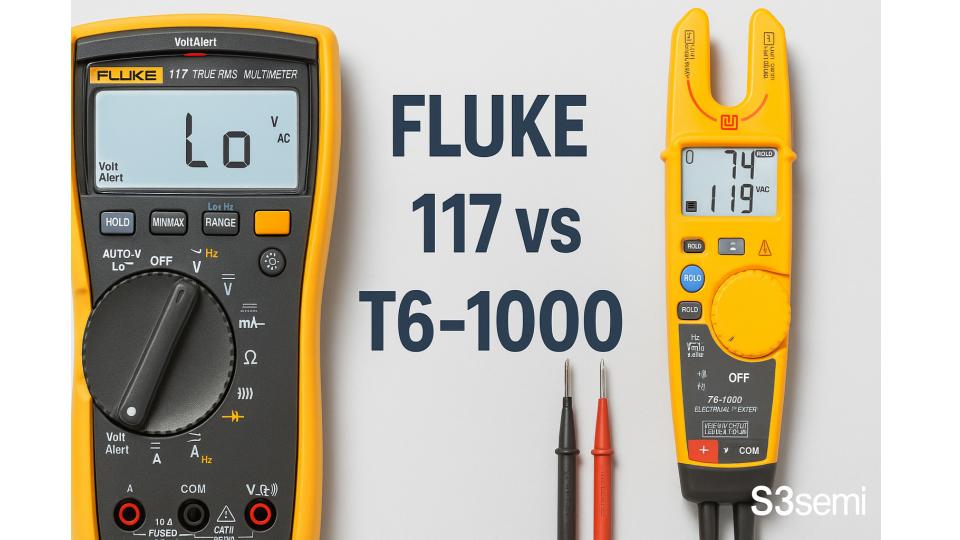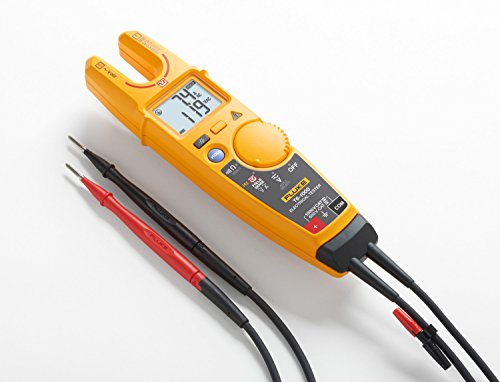Two popular Fluke models that serve different types of users are the Fluke 117 Electrician’s Multimeter and the Fluke T6-1000 Electrical Tester. While they may seem similar at first glance, they’re built with very different purposes in mind.
🏷️ Fluke Multimeter Deals ⭐⭐⭐⭐
This article compares the two so you can decide which one best fits your needs.
📊 Comparison Table
| Feature | Fluke 117 | Fluke T6-1000 |
|---|---|---|
| Type | Digital Multimeter | Electrical Tester |
| True-RMS | ✅ | ✅ |
| Voltage Measurement | Up to 600V AC/DC | Up to 1000V AC/DC |
| Current Measurement | Up to 10A (via leads) | Up to 200A (open fork) |
| Resistance, Continuity, Capacitance | ✅ | ✅ |
| Frequency | ✅ | ✅ |
| Non-Contact Voltage Detection | ✅ (VoltAlert) | ✅ (FieldSense) |
| LoZ (Ghost Voltage Elimination) | ✅ | ❌ |
| Display | Backlit digital | Backlit digital |
| Safety Rating | CAT III 600V | CAT III 1000V / CAT IV 600V |
| Portability | Compact handheld | Slim, field-friendly design |
| Price | 💲 Check Price | 💲 Check Price |
📋 Overview of the Fluke 117
The Fluke 117 is designed specifically for electricians in residential and commercial environments. It’s a compact, professional-grade multimeter that combines reliability with convenience.
Key Features:
- True-RMS for accurate measurements on non-linear loads.
- VoltAlert™ non-contact voltage detection.
- AutoVolt automatic AC/DC voltage selection.
- LoZ (Low Input Impedance) to eliminate ghost voltages.
- Measures voltage, current, resistance, continuity, frequency, and capacitance.
- Large backlit display.
- Safety rating: CAT III 600V.
Best for: Electricians and technicians who need precise, versatile measurements in everyday troubleshooting.
📋 Overview of the Fluke T6-1000
The Fluke T6-1000 Electrical Tester takes a different approach. Instead of being a traditional multimeter, it’s a field tester with open-jaw technology, allowing you to measure voltage and current without test leads.
Key Features:
- FieldSense™ technology: Measures AC voltage, current, and frequency without test leads.
- Open-fork design fits wires up to AWG 4/0 (120 mm²), measuring up to 200 A.
- Measures AC/DC voltage up to 1000V.
- Rugged and portable design.
- Safety rating: CAT III 1000V, CAT IV 600V.
Best for: Electricians and field technicians who want fast, safe, and lead-free voltage and current measurements.
👍 Pros & Cons of Each
Fluke 117
Pros:
- Professional-grade multimeter for electricians.
- VoltAlert for non-contact detection.
- LoZ prevents ghost readings.
- AutoVolt saves time when testing.
- Great all-around troubleshooting tool.
Cons:
- Limited to 600V range.
- Current measurement limited to 10A.
- Requires test leads for most functions.
Fluke T6-1000
Pros:
- FieldSense allows safe, lead-free voltage and current measurements.
- Handles up to 1000V and 200A.
- Rugged and designed for quick testing in the field.
- Higher safety category rating (CAT IV 600V).
Cons:
- Less precise for detailed electrical measurements compared to a multimeter.
- More expensive.
- Not ideal for electronics or fine troubleshooting.
🏁 Which One Should You Choose?
- Choose the Fluke 117 if you’re a professional electrician or technician who needs a compact, precise, all-around multimeter for troubleshooting in residential and commercial environments.
- Choose the Fluke T6-1000 if you work in the field with high-voltage equipment and want fast, safe, lead-free measurements of current and voltage.
Both are excellent tools, but their strengths are different — the 117 excels at detailed multimeter tasks, while the T6-1000 shines in quick, high-voltage field testing.





